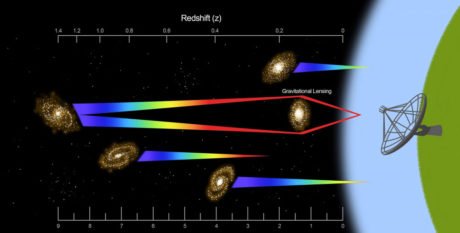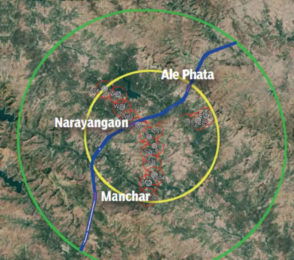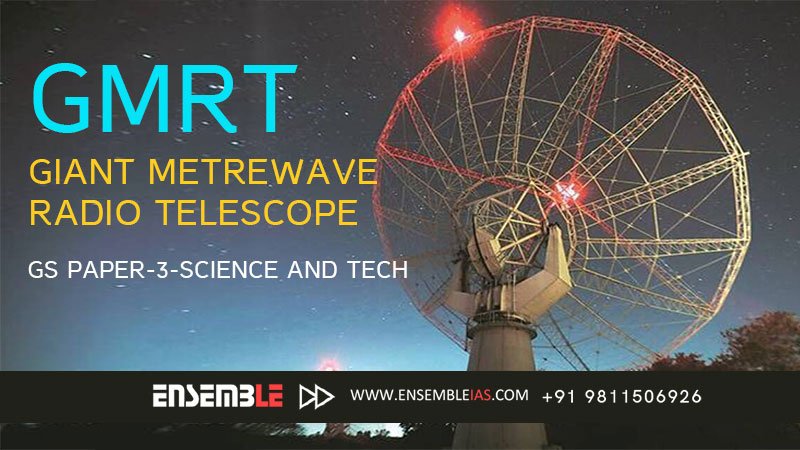Giant Metrewave Radio Telescope (GMRT)
NCRA has set up a unique facility for radio astronomical research using the meter wavelength range of the radio spectrum, known as the Giant Metrewave Radio Telescope (GMRT), it is located at a site about 80 km north of Pune. GMRT consists of 30 fully steerable gigantic parabolic dishes of 45m diameter each spread over distances of upto 25 km.
The link to join the course : Online Courses
Why metre wavelengths :
The metre wavelength part of the radio spectrum has been particularly chosen for study with GMRT because man-made radio interference is considerably lower in this part of the spectrum in India. Although there are many outstanding astrophysics problems which are best studied at metre wavelengths, there has, so far, been no large facility anywhere in the world to exploit this part of the spectrum for astrophysical research.

The site :
The site for GMRT, about 10 km east of Narayangaon town on the Pune-Nasik highway, was selected after an extensive search in many parts of India, considering several important criteria such as low man-made radio noise, availability of good communication, vicinity of industrial, educational and other infrastructure and,a geographical latitude sufficiently north of the geomagnetic equator in order to have a reasonably quiet ionosphere and yet be able to observe a good part of the southern sky as well.

Six huge telescopes in the world, including India’s Giant Metrewave Radio Telescope (GMRT), were crucial in supplying proof that gravity waves exist through pulsar observations.
These findings offer a glimmer of proof for the ultra-low frequency gravitational waves’ constant shaking of the universe’s fabric. These waves are anticipated to come from numerous dancing monster black hole pairings that are millions of times heavier than the sun.
Pulsars are highly magnetized, rotating neutron stars emitting a beam of electromagnetic radiation. They are usually detected in the form of short bursts of radio emission; however, some of them are also observed via optical, X-ray and gamma-ray telescopes.
In essence, pulsars are the embers of dead stars that are present in our galaxy and are a form of fast revolving neutron star. A pulsar releases radio beams that flash by the Earth on a regular basis, much like a harbour lighthouse, making it resemble a cosmic lighthouse.
Many signals are moving through the universe’s spacetime. Yet, when these signals are detected from Earth, the presence of gravitational waves affects how quickly they arrive. These experiments revealed that some signals arrive ahead of schedule while others do so with a minor delay (less than a millionth of a second).
These nano-hertz signals were perceived as the universe humming. They were brought on by the presence of gravitational waves and anomalies in the pulsar signals.
The results released today signal the start of a new voyage into the Universe to solve some of these riddles, according to Professor A. Gopakumar, TIFR, Mumbai and Chair of the InPTA consortium. More significantly, this is the first time gravitational wave detection has been done using data from an Indian telescope.
Giant Metrewave Radio Telescope (GMRT)
(http://www.gmrt.ncra.tifr.res.in/gmrt/intro_gmrt.html)
Best Online Coaching for Civil Service_IAS_ UPSC_IFS_IPS, Free Study Material ENSEMBLE IAS ACADEMY
Call +91 98115 06926
Visit us:- https://ensembleias.com/
Online Store: https://online.ensemble.net.in/
Email: [email protected]
#GMRT #Giant_Metrewave_Radio_Telescope #GS_Paper3 #developed_countries #developingcountries #GSPaper3 #Social_Issues #economy# #civilservicesstudy #ensembleiasacademy #geographyoptional #k_siddharthasir #ias #civilservices #upsc_motivation #upsc_aspirants #upsc_exam #trendsingeography #trendofquestions #geographytrends #civilservicesstudy #ensembleiasacademy #geographyoptional #k_siddharthasir #ias #civilservices #upsc_motivation #upsc_aspirants #upsc_exam #strategicthinker




